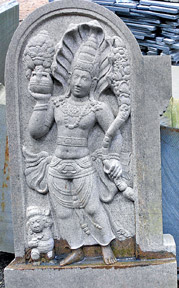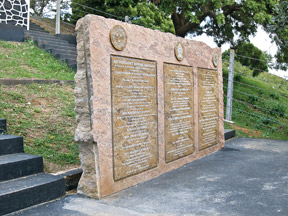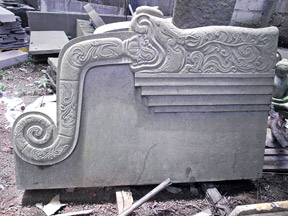|

Is tombstone industry a thing of the past?
By Anuradha GODAGODA
|

Guard Stones (Muragal)
|
These are some of the common verses found on tombstones erected in
memory of the dead carved on tombstones but now it is a dying art Gone,
but not forgotten ...In loving memory ...To live in the hearts of those
we love is never to die ... Entered into rest ...Until we meet again
...I shall but love thee better after death ...Forever in our hearts
...Always in our hearts ...At rest with God ...Rest in Peace ...Too well
loved to ever be forgotten ...Asleep in Jesus ...Home with God, which is
far better ...
The stele (plural stelae), as it is called in an archaeological
context, is one of the oldest forms of funerary art. Originally, a
tombstone was the stone lid of a stone coffin, or the coffin itself, and
a gravestone was the stone slab that was laid over a grave. Now all
three terms are also used for markers placed at the head of the grave.
Some graves in the 18th century also contained footstones to demarcate
the foot end of the grave. This sometimes developed into full kerb sets
that marked the whole perimeter of the grave. Footstones were rarely
annotated with more than the deceased's initials and year of death, and
sometimes a memorial mason and plot reference number. Many cemeteries
and churchyards have removed those extra stones to ease grass cutting by
machine mower. Note that in some UK cemeteries the principal, and indeed
only, marker is placed at the foot of the grave.
Graves, and any related memorials are a focus for mourning and
remembrance. The names of relatives are often added to a gravestone over
the years, so that one marker may chronicle the passing of an entire
family spread over decades. Since gravestones and a plot in a cemetery
or churchyard cost money, they are also a symbol of wealth or prominence
in a community. Some gravestones were even commissioned and erected to
their own memory by people who were still living, as a testament to
their wealth and status. In a Christian context, the very wealthy often
erected elaborate memorials within churches rather than having simply
external gravestones. Crematoria frequently offer similar alternatives
to families who do not have a grave to mark, but who want a focus for
their mourning and for remembrance. Carved or cast commemorative plaques
inside the crematorium for example may serve this purpose.
Tombstone makers are engaged in their day-to-day activities with
granite. Granite pieces or large blocks taken from huge rocks. These
granite rocks are found in many places such as Kaduwela, Ranala, Gampaha,
Avissawella, Matugama, Kurunegala, Homagama and Puwakpitiya.
 |
 |
|
N. Jayasinghe finishing a plaque |
Lakshman Kithulgoda |
Although a large quantity of granite rocks are found, people who are
engaged in the industry still import granite blocks from India to make
tombstones.
Tombstone makers only engage in making tombstones and commemorative
plaques. Now, they also make certain household items such as tables,
chairs, kitchen utensils, garden pots, flour pots, gift items, stair
cases for houses and statues out of granite.
Sri Lanka's granite industry has a record history of over 2500 years
coming from the time of king Vijaya.
Our history reveals that people who worked for king Vijaya were
engaged in the granite industry. Even after this period, ancient Sri
Lankans who worked for kings such as the great Parakramabahu, kings
Dutugamunu, Devanampiyatissa , Kavantissa , Datusena and Agbo helped to
construct castles, statues, canals and massive lakes with heavy granite
boulders. People living in the olden days also made weapons out of
granite.

Tombstones |

Plaques on display
Korawak Gala ( Special seat made out of granite) |
As there was no sophisticated machinery in the old days, people took
months and months to manufacture goods out of granite. The situation of
the granite industry is completely different now.
The Sunday Observer last week visited several places such as Henegama
in the Gampaha District, Panadura in the Kalutara District, Borella in
Colombo and Talahena in Kaduwela to meet tomb stone makers to seek their
views on the industry.
A long standing tombstone maker and the owner of Darshana Gal Ketayam
at Henagama, Lakshman Kithulgoda said his grandfather William Singho
Kithulgoda started the industry in 1911 as a self-employment project and
after his demise, the industry was taken over by his father Karunadasa
Kithulgoda.
My grandfather and father sacrificed their lives to development this
industry. They shed their sweat and toil and created very beautiful
commemorative plaques and also tombs tones,".He said like in the present
day, no technology was available to finish products and sometimes it
took even months to make a single granite product.
Lakshman said although he took over the industry from his father in
1989, he was not in a sound financial position to develop it and
thereafter he had to obtain a loan of Rs. 10,000 to expand the industry.
Over 35 people were working in his factory at Keragala, Henegama.
Lakshman said he manufactured commemorative plaques to commemorate
important foundation laying and opening ceremonies at the Hambantota
Port, Kinniya Bridge, Mattala Airport, Katugastota Bridge, Madu Church,
Mehewara Piyasa, Chandrika Wewa development Project etc.
He said he undertook the construction of the tombstones of Former
Ministers Jayeraj Fernandopulle and Regi Ranatunga.
Lakshman also said commemorative plaques and tomb stones are sold
from Rs. 30,000 up to Rs. Five lakhs, depending on the size of the
product.
He said he has another plan to send plaques to foreign countries in
the future.
The owner of Jayasinghe and sons of Borella and the makers of
tombstones, plaques and monuments, N. Jayasinghe said he started the
industry in 1985 following his father's death and he earns a sufficient
income from it.
"We buy small granite blocks from metal quarries at Labugama and
Avissawella and manufacture tomb stones and commemorative plaques.
He said the Government should give a helping hand to persons, who are
engaged in the tombstone industry and proposed the Government to
introduce a bank loan scheme , so that this industry could be developed
to a greater extent.
Nimal Senaka of Kaduwela said he owns a small shop and manufactures
only few tombstones every month. He said in addition he makes Buddha
statues from granite blocks.
Fifty-year-old , Raja Perera of Panadura who makes commemorative
plaques for various ceremonies said unless there is Government
assistance this industry will not survive.
He proposed the authorities to conduct exhibitions for the benefit of
tombstone in the country, as it will be a great help to them especially
small industrialists to expand their business activities.
He said large scale tombstone makers in the country are Darshana Gal
Ketayam of Henegama, Ally Weerasinghe of Mattakkuliya and Free Lanaka
Trading of Homagama. |

